Safari seasons in Northern Tanzania |
 |
January |
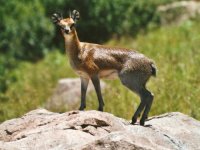 Occasional showers can be expected in January. The rains from early November to late March are usually sporadic and typically do not last for more then a few hours. There is a chance of heavier rain during this period but during most years the heavier rains fall in April. These expected sporadic showers do not usually pose much of an inconvenience while game driving. If it does rain, it will usually clear in 2-3 hours and more then likely the rain will be localized. It is rare that rain clouds will settle over a large area for an extended period of time. Occasional showers can be expected in January. The rains from early November to late March are usually sporadic and typically do not last for more then a few hours. There is a chance of heavier rain during this period but during most years the heavier rains fall in April. These expected sporadic showers do not usually pose much of an inconvenience while game driving. If it does rain, it will usually clear in 2-3 hours and more then likely the rain will be localized. It is rare that rain clouds will settle over a large area for an extended period of time.
|
February |
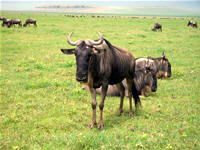 Occasional showers can be expected in February. The rains from early November to late March are usually sporadic and typically do not last for more then a few hours. There is a chance of heavier rain during this period but during most years the heavier rains fall in April. These expected sporadic showers do not usually pose much of an inconvenience while game driving. If it does rain, it will usually clear in 2-3 hours and more then likely the rain will be localized. It is rare that rain clouds will settle over a large area for an extended period of time Occasional showers can be expected in February. The rains from early November to late March are usually sporadic and typically do not last for more then a few hours. There is a chance of heavier rain during this period but during most years the heavier rains fall in April. These expected sporadic showers do not usually pose much of an inconvenience while game driving. If it does rain, it will usually clear in 2-3 hours and more then likely the rain will be localized. It is rare that rain clouds will settle over a large area for an extended period of time
|
March |
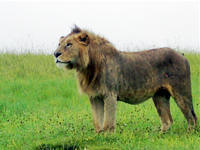 The rains from early November to late March are usually sporadic and typically do not last for more then a few hours. These expected sporadic showers do not usually pose much of an inconvenience while game driving. There is a chance of heavier rain during this period but during most years the heavier rain falls in late March and April. If it does rain, it will usually clear in 1-3 hours and more then likely the rain will be localized. It is rare that rain clouds will settle over a large area for an extended period of time. Late March usually heralds the beginning of the so called ‘long rains’ which simply does not mean much of anything in the Serengeti and is more applicable to other areas in Tanzania. However, there is risk of heavier rain in late March, which may pose an inconvenience while game driving. This risk is mitigated by the fact that it tends to rain less on the Serengeti plains where the best wildlife viewing is located during March. We strongly recommend longer duration safaris during late March, April and early May. We view the extra night or two as insurance against the potential of sour weather having a negative impact on any one day The rains from early November to late March are usually sporadic and typically do not last for more then a few hours. These expected sporadic showers do not usually pose much of an inconvenience while game driving. There is a chance of heavier rain during this period but during most years the heavier rain falls in late March and April. If it does rain, it will usually clear in 1-3 hours and more then likely the rain will be localized. It is rare that rain clouds will settle over a large area for an extended period of time. Late March usually heralds the beginning of the so called ‘long rains’ which simply does not mean much of anything in the Serengeti and is more applicable to other areas in Tanzania. However, there is risk of heavier rain in late March, which may pose an inconvenience while game driving. This risk is mitigated by the fact that it tends to rain less on the Serengeti plains where the best wildlife viewing is located during March. We strongly recommend longer duration safaris during late March, April and early May. We view the extra night or two as insurance against the potential of sour weather having a negative impact on any one day
|
April |
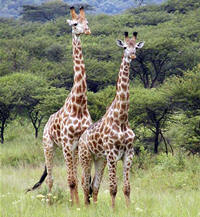 There is a chance of heavy rain during April and lighter showers can be expected for a few hours every day or every other day. However, when it does rain, it will usually clear in 1-3 hours and more then likely the rain will be localized. It is rare that rain clouds will settle over a large area for an extended period of time. The highest amounts of precipitation are historically seen in April for most parts of East Africa though not in the Southern Serengeti. The greatest amounts of precipitation are historically recorded in March in the Southern Serengeti. This is the season of the so-called ‘long rains’, which simply does not mean much of anything in the Serengeti and is more applicable to other areas in East Area. There is a risk that the heavier rains will pose an inconvenience on game drives. This risk is mitigated by the fact that it tends to rain less on the Serengeti plains where the best wildlife viewing is located during April. Additionally, we believe the month April offers the finest game viewing opportunities out of the entire year. We strongly recommend longer duration safaris during April. We view the extra night or two as insurance against the potential of sour weather having a negative impact on any one day. There is a chance of heavy rain during April and lighter showers can be expected for a few hours every day or every other day. However, when it does rain, it will usually clear in 1-3 hours and more then likely the rain will be localized. It is rare that rain clouds will settle over a large area for an extended period of time. The highest amounts of precipitation are historically seen in April for most parts of East Africa though not in the Southern Serengeti. The greatest amounts of precipitation are historically recorded in March in the Southern Serengeti. This is the season of the so-called ‘long rains’, which simply does not mean much of anything in the Serengeti and is more applicable to other areas in East Area. There is a risk that the heavier rains will pose an inconvenience on game drives. This risk is mitigated by the fact that it tends to rain less on the Serengeti plains where the best wildlife viewing is located during April. Additionally, we believe the month April offers the finest game viewing opportunities out of the entire year. We strongly recommend longer duration safaris during April. We view the extra night or two as insurance against the potential of sour weather having a negative impact on any one day.
|
May |
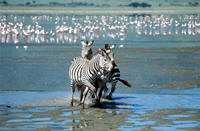 May heralds the end of the wet season, which lasts from about the beginning of November to mid May. By mid May, the weather generally begins to clear and all the parks begin their season of change. There is a chance of heavy rain in the beginning of May and lighter showers can be expected for a few hours every other day during the remainder of May. However, when it does rain, it will usually clear in 1-4 hours and more then likely the rain will be localized. It is rare that rain clouds will settle over a large area for an extended period of time. May is the end of the season of the so-called ‘long rains’, which simply does not mean much of anything in the Serengeti and is more applicable to other areas in East Area. There is a risk that the heavier rains will pose an inconvenience on game drives especially during the beginning of May. This risk is mitigated by the fact that it tends to rain less on the Serengeti plains where the best wildlife viewing is located during May. Additionally, we believe the month of May offers superb game viewing opportunities. We strongly recommend longer duration safaris during the beginning May. We view the extra night or two as insurance against the potential of sour weather having a negative impact on any one day. May heralds the end of the wet season, which lasts from about the beginning of November to mid May. By mid May, the weather generally begins to clear and all the parks begin their season of change. There is a chance of heavy rain in the beginning of May and lighter showers can be expected for a few hours every other day during the remainder of May. However, when it does rain, it will usually clear in 1-4 hours and more then likely the rain will be localized. It is rare that rain clouds will settle over a large area for an extended period of time. May is the end of the season of the so-called ‘long rains’, which simply does not mean much of anything in the Serengeti and is more applicable to other areas in East Area. There is a risk that the heavier rains will pose an inconvenience on game drives especially during the beginning of May. This risk is mitigated by the fact that it tends to rain less on the Serengeti plains where the best wildlife viewing is located during May. Additionally, we believe the month of May offers superb game viewing opportunities. We strongly recommend longer duration safaris during the beginning May. We view the extra night or two as insurance against the potential of sour weather having a negative impact on any one day.
|
June |
Early June marks the beginning of the dry season, which lasts from about the end of May to the end of October. By early June, the skies have cleared and all the parks have begun their season of change. The landscape changes dramatically as the parks dry out starting first with the plains and last with the woodlands. The weather will be mostly sunny with only a slight chance of rain.
Temperatures are pleasant with an average high of 81 degrees and an average low of 56 degrees. However, the rim of the Ngorongoro Crater can get quite cold at night and in the early morning. Visitor numbers drop off dramatically at the beginning of March and during April and May the parks are completely empty of tourists. Visitor numbers are still low in the beginning of June but begin to rise to moderately high numbers at the end of June |
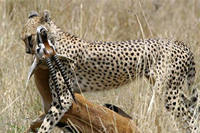 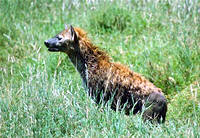 |
July |
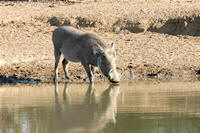 The weather in July can be characterized as dry and sunny. The landscape is now in stark contrast to the green season of only two months prior. The long grass is dying back and as the season progresses more and more animals congregate in the woodlands and around the remaining permanent sources of water. Temperatures are pleasant with an average high of 83 degrees and an average low of 60 degrees. However, the rim of the Ngorongoro Crater can get quite cold at night and in the early morning. Visitor numbers increase dramatically over July and they peak in August. The good news is that the vast majority of people are on package tours staying at the main lodges and zipping around the main roads in only a few popular areas. With careful planning we can customize your safari so you will encounter more Animals than people in even the busiest months of July and August. The weather in July can be characterized as dry and sunny. The landscape is now in stark contrast to the green season of only two months prior. The long grass is dying back and as the season progresses more and more animals congregate in the woodlands and around the remaining permanent sources of water. Temperatures are pleasant with an average high of 83 degrees and an average low of 60 degrees. However, the rim of the Ngorongoro Crater can get quite cold at night and in the early morning. Visitor numbers increase dramatically over July and they peak in August. The good news is that the vast majority of people are on package tours staying at the main lodges and zipping around the main roads in only a few popular areas. With careful planning we can customize your safari so you will encounter more Animals than people in even the busiest months of July and August.
|
August |
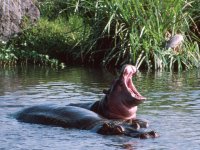 The weather in August is dry and sunny. The landscape is parched as the dry season has completely taken hold. The long grasses have died back, which makes game Drive easier and many of the animals congregate in the woodlands and around the remaining sources of water. The weather in August is dry and sunny. The landscape is parched as the dry season has completely taken hold. The long grasses have died back, which makes game Drive easier and many of the animals congregate in the woodlands and around the remaining sources of water.
Temperatures are pleasant with an average high of 81 degrees and an average low of 55 degrees. However, the rim of the Ngorongoro Crater can get quite cold at night and in the early morning. Visitor numbers increase dramatically over July and they peak in August. August is the busiest month of the year. The good news is that the vast majority of people are on package tours staying at the main lodges and zipping around the main roads in only a few popular areas. With careful planning we can customize your safari so you will encounter more Animas than people in even the busiest months of July and August.
|
September |
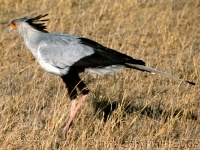 The weather in September is dry and sunny. The landscape is parched as the dry season has completely taken hold. The long grasses have died back, which makes game viewing easier and many of the animals congregate in the woodlands and around the remaining sources of water. The weather in September is dry and sunny. The landscape is parched as the dry season has completely taken hold. The long grasses have died back, which makes game viewing easier and many of the animals congregate in the woodlands and around the remaining sources of water.
Temperatures are pleasant with an average high of 81 degrees and an average low of 55 degrees. However, the rim of the Ngorongoro Crater can get quite cold at night and in the early morning. Visitor numbers increase dramatically over July and they peak in August. Visitor numbers are at their highest in August but drop off dramatically in mid to late September. The good news is that the vast majority of people are on package tours staying at the main lodges and zipping around the main roads in only a few popular areas. With careful planning we can customize your safari so you will encounter more lions than people in even the busiest months
|
October |
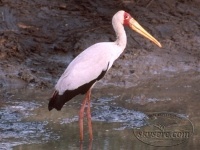 The weather in October is generally dry and sunny. However, occasional light showers may occur in late October. The landscape is parched as the dry season has completely taken hold. The long grasses have died back, which makes game viewing easier and many of the animals congregate in the woodlands and around the remaining sources of water. The weather in October is generally dry and sunny. However, occasional light showers may occur in late October. The landscape is parched as the dry season has completely taken hold. The long grasses have died back, which makes game viewing easier and many of the animals congregate in the woodlands and around the remaining sources of water.
Temperatures are pleasant with an average high of 83 degrees and an average low of 60 degrees. However, the rim of the Ngorongoro Crater can get quite cold at night and in the early morning. Visitor numbers are very high during the summer months of July, August and early September. As the summer holiday period comes to in end, visitor numbers drop off dramatically. By October, visitor numbers are relatively low, which combined with good game Drive opportunities makes this month an excellent choice for a safari.
|
November |
Occasional showers can be expected in November. In late November, towering thunderclouds form and herald the onset of the green season. November is a period of dramatic change as the rains transform the parched landscape.
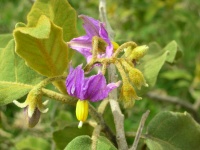 The rains from early November to late March are usually sporadic and typically do not last for more then a few hours. There is a chance of heavier rain during this period but during most years the heavier rains fall in April. These expected sporadic showers do not usually pose much of an inconvenience while game driving. If it does rain, it will usually clear in 1-3 hours and more then likely the rain will be localized. It is rare that rain clouds will settle over a large area for an extended period of time. The rains from early November to late March are usually sporadic and typically do not last for more then a few hours. There is a chance of heavier rain during this period but during most years the heavier rains fall in April. These expected sporadic showers do not usually pose much of an inconvenience while game driving. If it does rain, it will usually clear in 1-3 hours and more then likely the rain will be localized. It is rare that rain clouds will settle over a large area for an extended period of time.
Rain falls in different amounts over various locations throughout Northern Tanzania. The Ngorongoro Crater, Tarangire and Lake Manyara receive higher rainfall then many parts of the Serengeti. There is a steep rainfall gradient in the Serengeti from the dry southeast to the wet northwest. The winds that bring rain blow from the east. The Ngorongoro Highlands block much of the rain from reaching the eastern and southern plains of the Serengeti. However, the western and northern parts of the Serengeti receive a much greater amount (2-3 times more) of participation as compared to the southern and eastern Serengeti. The wetter western and northern Serengeti areas are affected by Lake Victoria. |
December |
Occasional showers can be expected in December. The rains from early November to late March are usually sporadic and typically do not last for more then a few hours. There is a chance of heavier rain during this period but during most years the heavier rains fall in April. These expected sporadic showers do not usually pose much of an inconvenience while game Viewing. If it does rain, it will usually clear in 1-2/3 hours and more then likely the rain will be localized. It is rare that rain clouds will settle over a large area for an extended period of time.
Rain falls in different amounts over various locations throughout Northern Tanzania. The Ngorongoro Crater, Tarangire and Lake Manyara receive higher rainfall then many parts of the Serengeti. There is a steep rainfall gradient in the Serengeti from the dry southeast to the wet northwest. The winds that bring rain blow from the east. The Ngorongoro Highlands block much of the rain from reaching the eastern and southern plains of the Serengeti. However, the western and northern parts of the Serengeti receive a much greater amount (2-3 times more) of participation as compared to the southern and eastern Serengeti. The wetter western and northern Serengeti areas are affected by Lake Victoria. This means that in the southern Serengeti where you should ideally focus your December safari, the rains should not be an issue and it will rain substantially less then the other areas of the Serengeti and Tanzania.Temperatures are pleasant with an average high of 83 degrees and an average low of 60 degrees. However, the rim of the Ngorongoro Crater can get quite cold at night and in the early morning. Visitor numbers will be low in early December and very high in late December with the New Year's crowd. The good news is that the vast majority of people are on package tours staying at the main lodges and zipping around the main roads in only a few popular areas. With careful planning we can customize your safari so you will encounter more lions than people in even late December. |
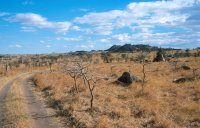 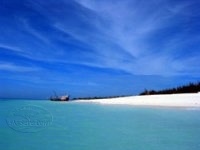 |

